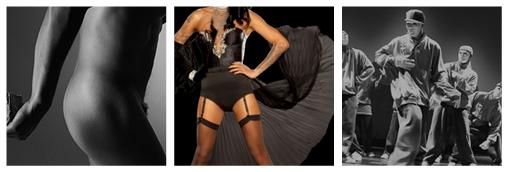When talking about gay bars of Manila
However, little is mentioned about those others performing in the gay bar, those with the same night-shift work schedules, who share the same stage and entertain the same audience, as the macho dancers.
“Sino yang mga yan? (Who are they?)” might be asked by puzzled first time gay bar goers, who went to that bar to see some naked muscular men. After sets of erect dicks on stage, these customers would be seeing fully-clothed effeminates doing drag or fully-clothed boys doing hiphop.
They’re employed by the bar, along with the macho men, and they're there to entertain. As "commercial breaks", they give sort of a breather to the continuous flow of half-naked men dancing routinely under the spotlight.
They’re employed by the bar, along with the macho men, and they're there to entertain. As "commercial breaks", they give sort of a breather to the continuous flow of half-naked men dancing routinely under the spotlight.
 |
| Those who go "area": (1) All-the-way men who don't get tabled often, (2) Drag queen impersonators, (3) Hiphop dance groups |
On-stage, the tranny impersonators might do a burlesque show or lip-synching divas concert. The hiphop group dancers might do a medley of latest radio hits. And right after a one-song performance onstage, they would go down the stage with the second song as their cue. This is the so-called bar term "area" (or “ehr-ya”, as how the gay bar employees pronounce it).
It's a term commonly used in gay bars: "Ayan, mag-a-area na ang mga impersonator (The impersonators will now go on 'area')" or "Ang lakas nila humingi ng pera kapag nag-area (Those dancers ask for too much money when they 'area')".
It's a term commonly used in gay bars: "Ayan, mag-a-area na ang mga impersonator (The impersonators will now go on 'area')" or "Ang lakas nila humingi ng pera kapag nag-area (Those dancers ask for too much money when they 'area')".
When they "area" (yes, a noun used as a verb), each of the group’s members would be assigned “areas” inside the gay bar with a little bag or cap in their hands. They approach a customer's group, like yours for instance, either with a smile or a little plea, and hope that you give them some tip or change. The drag queens might seduce with a brief dance in front of you. A member of the dance crew might use their boyish charms. And after your generous action (or inaction), they move on to the next table and to the next, until they’ve gone through all the customers before their song would end.
Collecting tips from customers via doing “area” is a way for these in the periphery to augment their daily income, which they split evenly among themselves. Sure, the bar pays these impersonators and group dancers for their performances, but the top of the pay roll would always be the macho dancers. But unlike the macho dancers, they don't collect commission from the drinks from the customers, nor get the much higher tips. Heck, they don't even get extravagant gifts from crazy-in-love guests outside the bar. What do these impersonators or group dancers, and to some extent, the not-so-handsome all-the-way tigas boys get from the customers? Much smaller than the MDs, if not, none.
For them, the tips they collect reflect the generosity of the customers. They know how the gay bar’s patrons are always loaded, just by how the MD drinks are priced. “Nagtatapon naman sila ng pera, bakit hindi rin makakuha? (They’re throwing away money, so why not get some of those)” as remarked by one. They also seem drawn to foreigners, as much larger tips are given by caucasian foreigners who seem to be easily entertained. For some customers, these acts of begging may seem like little ways of extorting money from them. Of course, there are the choosy customers who’d select who to give and how much, if ever they’d decide to be generous. A simple "no" or slight wave of the customer's hands automatically signals these dancers to leave.
The tips also give an indication of the bar’s financial situation. No customers for weeks, no tips.
“Nagkaroon ng time, halos walang customer na nagpupunta. Yung P100 na tip nung isa, pinaghahatian pa namin. Mas maliit pa yung tip kaysa sa biyahe. (There was a time, the bar was empty without any customers. We had to share the P100 given to us. What we got was smaller than the fare going to the bar),” as the tranny impersonator shared. This was at the height of the rainy season, when people would rather stay home than go out, and at the same months before the holiday season, when people would save their money for the following months’ spending. This was also the time when our group found another gay bar, with other men to spend our money at.
In a place where money seemed to be flowing freely night after night, there are those who don't benefit that much -- the drag queen impersonators, the dance groups, the all-the-way boys. The maximum P100 tips each group gets per customer (which they still split among them) are way smaller than the minimum P500 each macho dancer gets from their guests. Sex does sell, it seems.
Sure, they entertain the audiences, just as the macho men do. But it's a fact they accept that they are not the main reasons why patrons go to these macho dancing gay bars. Their performances are simply "commercial breaks" to the repetitive, routine live acts, and similarly, do we pay attention to the breaks on TV?
Why not? They may be more entertaining than the main show.
Photocredits:
GB Goer

No comments:
Post a Comment
Feel free to share what you think